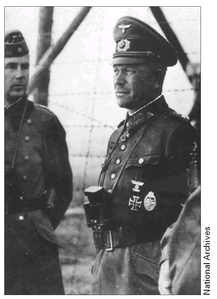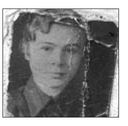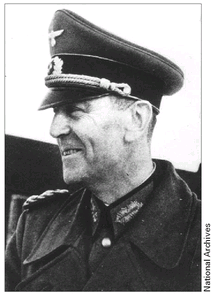War Stories III (10 page)
Authors: Oliver L. North

By 7 December 1941, the day that the Japanese bombed Pearl Harbor, the German army held a front that ran in a nearly straight line from Leningrad on the Gulf of Finland due south to the Crimea on the Black Sea. At that point, German troops controlled more than 40 percent of Russia's population, a near equal percentage of Soviet agricultural production, and more than half of the USSR's coal and steel capacity.
Yet, once the ground froze, the winter-ready Red Army was able to launch a series of limited counter-offensives. Zhukov pushed Army Group Center back from the gates of Moscowâprompting Hitler to fire von Bock and a host of his generalsâincluding Brauchitsch, his army commander in chief. Also among those relieved was Heinz Guderianâfather of Germany's Panzer blitzkrieg tactics.
Hitler appointed himself commander in chief of the army, and as his troops froze in defensive “hedgehogs” along the 1,100-mile front, he began concocting a revised grand strategy for 1942. His goals were mind-boggling. First, to finish off “the Bolshevik menace” for good in 1942âbefore the
Americans, against whom he had declared war on 11 Decemberâcould open a western front in Europe. Second, capture the oilfields, mines, and rich agricultural lands along the Volga River and the ridges of the Caucasusâall the way to Baku on the west shore of the Caspian Sea. And third, in concert with the Italians, seize Egypt, Palestine, Syria, Iraq, and the oilfields of Saudi Arabia.
Americans, against whom he had declared war on 11 Decemberâcould open a western front in Europe. Second, capture the oilfields, mines, and rich agricultural lands along the Volga River and the ridges of the Caucasusâall the way to Baku on the west shore of the Caspian Sea. And third, in concert with the Italians, seize Egypt, Palestine, Syria, Iraq, and the oilfields of Saudi Arabia.
The first major action after the spring thawâthe destruction of a Red Army counter-offensive at Kharkovâgave Hitler reason for optimism. By 1 June 1942, the Wehrmacht had captured nearly 240,000 Russian troops and destroyed over 1,200 tanks. But regrettably for the Axis soldiers who had to carry out the rest of the scheme, Hitler seriously underestimated the effect American industrial, agricultural, and military mobilization would have on his adversaries. By 28 June, when the ground was finally dry enough to launch his southern offensiveâcodenamed Blueâmassive quantities of food, clothing, ammunition, aircraft, and trucks from America were already reaching Russia.
Â
Heinz Guderian

And after the offensive was already well under way and Wehrmacht troops were bounding southeastward at twenty to thirty miles a day, the Führer made another strategic blunder. He decided that seizing a single cityâStalingradânamed for his Soviet nemesisâwas more important than any other part of his offensive.
On 23 July Hitler ordered Army Group Bânow commanded by General Maximilian von Weichsâto seize Stalingrad and force a crossing of the Volga. The resulting exhaustive campaign, which lasted from 21 August 1942 until 30 January 1943, would pit nearly two million Germans and their Romanian and Italian allies against 3.5 million Russians in the bloodiest battle of World War II.
Maria Faustova served in the Red Army Signal Corps during the merciless engagement. She was one of a handful of survivors in her unit.
MARIA FAUSTOVA, SOVIET SOUTHERN ARMY
Stalingrad, Russia
2 February 1943
2 February 1943

I wanted to become a teacher of Russian language and Russian literature and dreamed of becoming a literary scholar. My family and I lived in Stalingradâit used to be called Tsaritsynâbut it had it had been renamed. One of my grandfathers lived in Moscow and I planned on going there to continue my studies. But when the Germans invaded, those dreams were overâand so was my youth.
I first learned we were at war on the morning of June 22, 1941. We heard it on the radio and there was a call for volunteers. I told my parents that I wanted to help defend our country and so on July 23, a month after the war had started, I signed up. I was given a month of training with other new recruits and assigned to the Signal Corps as a radio operator.
During the fighting of 1941 and early 1942, I didn't see any action, though we all followed the news of what was happening to the people of Leningrad and Moscow. But in the spring of 1942, the Germans came for us.
There were a few bombing raids in the winter, when the Germans tried to knock out some of the factories along the Volga River, but starting in July of '42 it got very bad, with many air raids. The bombing went on day and night, every dayânot just on the factories and military installationsâbut on the apartments where we lived. The attacks were terrifyingâbut not as bad as what came next.
In August, the Germans broke through our defenses and into the city. Many civilians were killedâand the Stukas strafed them as they tried to get across the river. The battles were horrible.
I was a radio operator for a rifle regiment and one afternoon in September, an enemy tank unit broke through our front line and started coming down the street toward us. We were in the basement of a wrecked
building and didn't have any place to hide. The Germans surrounded us, but after dark we were able to go through the cellars from one smashed building to another and move our headquarters to the basement of another bombed-out building.
building and didn't have any place to hide. The Germans surrounded us, but after dark we were able to go through the cellars from one smashed building to another and move our headquarters to the basement of another bombed-out building.
We were trying to hold the center of the city, but almost no one was left. The Germans bombed and shelled us every day, trying to bring the buildings down on our heads. There were only walls of the buildings, and we hid in basements. It was like hell. All the people around me were dying, one after the other.
By winter it was terrible for everyone. There was no electricity, no way to stay warm. Many days we had no food. Some of the wounded froze to death waiting for treatment. The civilians who couldn't get away hid in the basements with us, and it was even worse for them. My grandfather died of starvation and cold in January. My mother and sister were starving as well. Whenever I could I would bring them some of my Army rationsâmostly bread.
The fighting was brutalâfrom one basement to another. I don't think that there was a single building that wasn't badly damaged. The city was turned to rubbleâand we lived in it like rats.
Often we had no idea where the Germans were. If you went inside a building, the Germans could be in the basement. That's how we livedâright alongside the enemy.
It seems like every day we would have to moveâand always there was the roar of gunfire, mortars, rockets, bombs, and artillery. It was our artillery and Katusha rockets that finally saved us.
By January, we had more than 7,000 guns and thousands of Katusha launchers firing around the clock. That's how we fought our way back into the center of the cityâbehind a wall of fire from the rockets and artillery. By the time that the Germans surrendered at the end of January, we had been merged into the 35th Guard Division because everyone else was dead. We only had 124 people leftâout of 15,000âbut we had beaten the Germans.
Russian losses on the Eastern Front were staggering. But by the time German field marshal Friedrich Paulus surrendered the 91,000 survivors of his 6th Army on 30 January 1942, more than 145,000 of his soldiers lay dead in the rubble of Stalingrad. The Red Army had also destroyed Hitler's 4th Panzer Army, the 3rd and 4th Rumanian Armies, and the 8th Italian Armyâinflicting on the Wehrmacht and their Axis allies nearly 1.5 million killed, wounded, prisoners, and missing.
Adolf Hitler's dreams of world conquest died in the rubble of Stalingrad. The German army would never recover from its first major defeat. And Hitler's worst nightmare had come true: America was now in the war.
Â
Field Marshal Friedrich Paulus

CHAPTER 4
PLUNGED INTO WAR 1941
E
very American born before 1930 that I have interviewed for
War Stories
remembers exactly where they were and what they were doing when they learned that the Japanese had bombed Pearl Harbor. They recall the dateâSunday, 7 December 1941âwho they were with, and that on the radio President Roosevelt called it “a day of infamy.” They all also recollect knowing that, whether we wanted to be or not, America was now at war.
very American born before 1930 that I have interviewed for
War Stories
remembers exactly where they were and what they were doing when they learned that the Japanese had bombed Pearl Harbor. They recall the dateâSunday, 7 December 1941âwho they were with, and that on the radio President Roosevelt called it “a day of infamy.” They all also recollect knowing that, whether we wanted to be or not, America was now at war.
Yet, for those already fighting in the great cataclysm of World War II, the day passed like so many before and after. The fact that the United States was now a combatant didn't alter the agony and bloodshed a bit. Few of the combatants already engaged were even aware that the attack on Pearl Harbor had happenedânor could they foresee what it would mean for the outcome of the struggle.
For Wehrmacht and Russian soldiers locked in a frozen death-grip at Leningrad, the date of 7 December 1941 was just another day of pounding each other with artillery and hoping to survive sub-zero temperatures. At the center of the Eastern Front, despite Red Army losses of nearly two million dead and an equal number taken prisoner, Zhukov's 1st Shock Army
was in the second day of a two-week counter-attack through snowdrifts that would keep the Germans from storming the gates of Moscow. In the Crimea, Army Group South were moving their unit into position for another failed assault on Russian defenses at Sevastopol.
was in the second day of a two-week counter-attack through snowdrifts that would keep the Germans from storming the gates of Moscow. In the Crimea, Army Group South were moving their unit into position for another failed assault on Russian defenses at Sevastopol.
Â
Even before the U.S. entered the war, FDR and Churchill were preparing a strategy to defeat Hitler when they met off Argentia, Newfoundland, in August 1941.

It was much the same for participants in every other theater of war. In the North Atlantic, a Royal Canadian Navy corvette escorting a convoy from the U.S. to Britain collided with a merchantman in the midst of a German U-boat attackâsending twenty-three sailors to an icy death. In North Africa, Erwin Rommel's 240-day siege of the Australians at Tobruk was in its last horrible hours as Field Marshal Claude Auchinleck's British armored columns smashed into the Afrika Corps in Operation Crusader. And in China, Chiang Kai-shek's battered and poorly equipped armyâbarely holding the Nationalist Chinese “capital,” Kunmingâwas under relentless air attack from other Japanese bombers.
But if “Pearl Harbor Day” was unremarkable to the soldiers, sailors, and airmen already fighting, bleeding, and dying in Europe, Africa, Asia, and the North Atlanticâit was anything
but
routine to the leaders of those countries.
Though it would take Congress another full day to declare war on Japan, Canada did so that very afternoon.
but
routine to the leaders of those countries.
Though it would take Congress another full day to declare war on Japan, Canada did so that very afternoon.
Other books
Hijacked by Sidda Lee Tate
The Zombie Chasers #4 by John Kloepfer
'Til Death by Dante Tori
Seeds of Time by K. C. Dyer
The Storyteller's Daughter by Maria Goodin
The Coming of the Dragon by Rebecca Barnhouse
30 Guys in 30 Days by Micol Ostow
The Atlantis World (The Origin Mystery, Book 3) by A.G. Riddle
An Interrupted Marriage (Silhouette Special Edition) by Bright, Laurey